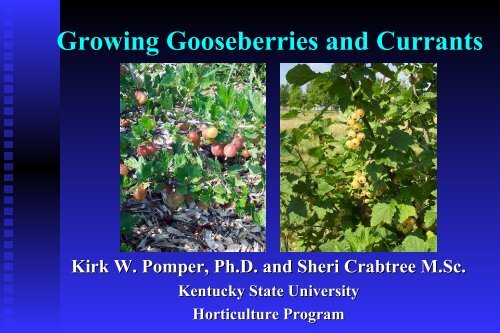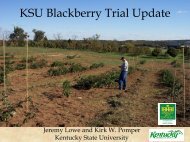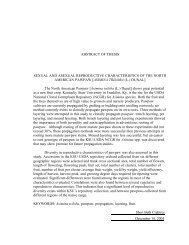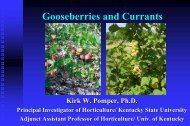Gooseberries and Currants - Kentucky State University Pawpaw ...
Gooseberries and Currants - Kentucky State University Pawpaw ...
Gooseberries and Currants - Kentucky State University Pawpaw ...
Create successful ePaper yourself
Turn your PDF publications into a flip-book with our unique Google optimized e-Paper software.
Growing <strong>Gooseberries</strong> <strong>and</strong> <strong>Currants</strong><br />
Kirk W. Pomper, Ph.D. <strong>and</strong> Sheri Crabtree M.Sc.<br />
<strong>Kentucky</strong> <strong>State</strong> <strong>University</strong><br />
Horticulture Program
<strong>Gooseberries</strong> <strong>and</strong> <strong>Currants</strong><br />
�<strong>Currants</strong> <strong>Currants</strong> <strong>and</strong><br />
gooseberries (Ribes ( Ribes) ) are<br />
berry producing shrubs<br />
�Types Types of currants: red,<br />
white, <strong>and</strong> black<br />
�American American <strong>and</strong> European<br />
gooseberries range from<br />
green to yellow, or red<br />
when ripe
Zante Currant (Black Corinth Grape):<br />
Not a Currant<br />
� The "currant" is one of the oldest<br />
raisins known<br />
� the term currant is used to describe its small<br />
berry size, but it is a true grape [Vitis [ Vitis vinifera] vinifera]<br />
<strong>and</strong> not a member of the Ribes genus.<br />
� In 75 A.D., Pliny writes of a tiny<br />
Greek grape, thin-skinned, juicy, <strong>and</strong><br />
sweet, <strong>and</strong> with bunches exceedingly<br />
small.<br />
� In the eleventh century, trade of this<br />
type of raisin between the Greek<br />
producers <strong>and</strong> the Venetians was<br />
recorded.
Gooseberry <strong>and</strong> Currant Products<br />
� Plants are hardy,<br />
easy to grow<br />
� Fruit makes<br />
excellent juices,<br />
wines, cassis, jams,<br />
jellies, preserves,<br />
<strong>and</strong> pies
What We Will Taste:
Nutritional Information on <strong>Currants</strong><br />
■ Black currants are high in anthocyanins, total<br />
phenolics <strong>and</strong> antioxidant capacity (Moyer et al.,<br />
2002a, 2002b).<br />
Hummer <strong>and</strong> Barney (2002) in HortTechnology 12:377-387
•North North American currant production is small <strong>and</strong><br />
unreported on the world market.<br />
•<strong>Currants</strong> <strong>Currants</strong> were grown widely in the U.S. <strong>and</strong> during the late<br />
1800s <strong>and</strong> early 1900s, when production was halted because<br />
of white pine blister rust.<br />
Hummer <strong>and</strong> Barney (2002) in HortTechnology 12:377-387
Propagation<br />
■ What is a Cultivar?<br />
■ Cultivar = refers to a named group of plants<br />
within a cultivated species that is distinguishable<br />
by a character or group of characters <strong>and</strong> that<br />
maintains its identity when propagated either<br />
asexually (e.g. ‘Jonathan’ apple) or sexually (e.g.<br />
‘Tendercrop’ snapbean)
Methods of Clonal Propagation<br />
■ grafting <strong>and</strong> budding<br />
■ stem cuttings<br />
■ root cuttings<br />
■ tissue culture<br />
■ air layering<br />
mound layering<br />
■ trench layering<br />
■ mound layering<br />
trench layering<br />
■ pot layering
Clonal propagation<br />
■ Stable reproduction of a superior variety<br />
■ Shorten time to flower <strong>and</strong> fruit if mature tissue<br />
used for propagation<br />
■ Reduce problems with seed production, storage,<br />
<strong>and</strong> germination<br />
◆ Recalcitrance <strong>and</strong> chilling<br />
■ Many woody fruit species are propagated by<br />
grafting or budding onto seedling or clonal<br />
rootstock (e.g., ‘Gala’ on M9)<br />
■ Clonal propagation on own roots eliminates graft<br />
incompatibility problems
‘Cone of Juvenility’<br />
■ Not all woody plants can<br />
be propagated by cuttings.<br />
■ Shoots arising from<br />
nearest to the roots are<br />
ontogenetically more<br />
juvenile <strong>and</strong> have greater<br />
rooting potential
Propagating <strong>Currants</strong><br />
■ <strong>Currants</strong> are easily<br />
propagated by hardwood<br />
cuttings of one-year old<br />
wood.<br />
◆ Take one-foot cuttings of<br />
dormant wood in late winter,<br />
dip the base in rooting hormone<br />
<strong>and</strong> pot in ordinary soil.<br />
◆ Cuttings will quickly root <strong>and</strong><br />
are best kept in part shade for<br />
the first year.
<strong>Currants</strong>: Field Propagation (fall)
Propagating <strong>Gooseberries</strong><br />
■ Tip layering is a surer<br />
method of propagation<br />
of gooseberries than<br />
cuttings.
Planting <strong>Gooseberries</strong> <strong>and</strong> <strong>Currants</strong><br />
■ Plants prefer a cool moist<br />
soil, well-drained, or a rich<br />
clay loam soil (pH 6 to 7.5)<br />
■ <strong>Currants</strong>: 2-4’ spacing<br />
<strong>Gooseberries</strong>: 4-5’ spacing<br />
■ Irrigation is helpful in<br />
summer in <strong>Kentucky</strong>
Pruning <strong>Gooseberries</strong><br />
<strong>and</strong> <strong>Currants</strong><br />
■ Produce the majority of their fruit on<br />
2 <strong>and</strong> 3-year-old shoots, <strong>and</strong> shoots<br />
4 years <strong>and</strong> older produce very little<br />
fruit.<br />
■ After the first growing season,<br />
remove all but 6 to 8 vigorous,<br />
healthy shoots.<br />
■ The following year, leave 4 or 5<br />
one-year-old shoots <strong>and</strong> 3 or 4 two-<br />
year-old canes.<br />
■ After the third growing season, keep<br />
3 or 4 shoots each of one-, two-, <strong>and</strong><br />
three-year-old growth.<br />
■ Prune in late winter or early spring
Tree Training
Gooseberry <strong>and</strong> Currant Yields<br />
■ <strong>Gooseberries</strong><br />
■ <strong>Currants</strong><br />
✦ 4 years to full<br />
production<br />
✦ about 4-5 quarts per<br />
bush<br />
✦ 4 years to full<br />
production<br />
✦ about 3-4 quarts per<br />
bush
Gooseberry <strong>and</strong> Currant Pests<br />
Red Lake Currant with mildew<br />
■ Diseases <strong>and</strong> Pests<br />
◆ White pine blister rust<br />
◆ Powdery mildew<br />
◆ Septoria leaf spot<br />
◆ Currant aphid<br />
◆ Currant fruit fly<br />
◆ Currant borer
White Pine Blister Rust<br />
■ Early in the 1900's, white pine blister rust became a<br />
serious disease problem in the United <strong>State</strong>s<br />
■ White pine blister rust requires both a Ribes species <strong>and</strong><br />
white pine to complete its life cycle<br />
■ In an attempt to prevent the spread of white pine blister<br />
rust, the federal government banned the planting <strong>and</strong><br />
cultivation of currants <strong>and</strong> gooseberries early in the<br />
twentieth century<br />
■ The federal government lifted the ban in 1966 <strong>and</strong> there<br />
are now currants <strong>and</strong> gooseberries that are resistant to<br />
white pine blister rust
WPBR on currant WPBR on Pine
WPBR on currants
White Pine Blister Rust<br />
■Plant Plant 1000 to 3000 ft from the<br />
nearest susceptible pines.<br />
■The The black currant cultivars:<br />
Consort, Coronet, Crusader, <strong>and</strong><br />
Titania are rust-immune.
Anthracnose<br />
Powdery mildew
Birds<br />
■ Robins love black currants <strong>and</strong> pink<br />
gooseberries<br />
■ Netting<br />
■ Bird alarms, CDs <strong>and</strong> pie tins tied to poles
■ <strong>Currants</strong>, gooseberries<br />
, <strong>and</strong> jostaberries: a guide for growers, ... - Google B
<strong>Gooseberries</strong>
‘Hinnomaki Red’<br />
■ Excellent raspberry<br />
flavor-tart<br />
■ Red berry when ripe<br />
■ Crunchy texture<br />
■ Good disease<br />
resistance
‘Hinnomaki Red’<br />
■ Low growing<br />
habit<br />
■ Wire?
‘Amish Red’<br />
■ Good flavor<br />
■ Red berry<br />
when ripe<br />
■ Good texture?<br />
■ Good disease<br />
resistance<br />
■ Limited<br />
availability
‘Poorman’<br />
■ Good flavor<br />
■ Red berry<br />
when ripe<br />
■ Good fruit<br />
texture?<br />
■ Less disease<br />
resistance<br />
◆ Leaf spot
‘Pixwell’<br />
■ Red-pink when<br />
ripe<br />
■ Berries hang<br />
below thorns,<br />
easier to pick<br />
■ Not much flavor<br />
■ Mushy texture
Other <strong>Gooseberries</strong> Planted at KSU<br />
■ ‘Invicta’ Invicta’ –green berry-poor survival<br />
■ ‘Jahns ‘ Jahns Prairie’-red berry-leaf spot problems<br />
■ ‘Captivator’-red Captivator’-red berry-leaf spot problems
New <strong>Gooseberries</strong> to Try:<br />
■ Tixia (Rafz Switerl<strong>and</strong>, 1990) has large<br />
(similar to Invicta), bright red fruit; elongated <strong>and</strong><br />
quite smooth that ripens mid-season. In addition<br />
to the attractive fruit, Tixia one year shoots have<br />
few thorns <strong>and</strong> the thorns are relatively soft;<br />
usually as single thorns with very few, if any, on<br />
the upper part of shoots. Growth is medium to<br />
strong, upright. NY
■ Friend<br />
Other Selections To Try:<br />
◆ A unique, thornless, Ukrainian variety, Friend bears good crops of<br />
medium to large , reddish-pink berries, good for fresh eating <strong>and</strong> for making<br />
delicious jam <strong>and</strong> pies. A unique disease resistant gooseberry from the<br />
Ukraine. (One Green World <strong>and</strong> Raintree Nurseries)<br />
■ Red George<br />
◆ features abundant crops of striking, very dark red, sweet <strong>and</strong> delicious fruit,<br />
which turns almost black when ripe. A valuable Ukrainian variety, Red<br />
George is an attractive, disease-resistant, easy to grow shrub. (One Green<br />
World <strong>and</strong> Raintree Nurseries)<br />
■ Jewel<br />
◆ Selected from a group of Polish seedlings, Jewel has rapidly become one<br />
of our favorite varieties. We like it for its profuse crops of unique, intensely<br />
flavored, peach colored berries. These sweet, delectable berries are great for<br />
eating fresh <strong>and</strong> for preserves <strong>and</strong> baked goods. We also appreciate its<br />
disease resistance <strong>and</strong> attractive, compact growth habit.
Cultivar<br />
<strong>Gooseberries</strong> at KSU<br />
Approximate<br />
harvest date<br />
Years in<br />
the field<br />
Yield z<br />
Berry<br />
weight<br />
(g) y<br />
Vigor x<br />
WPBR<br />
resistance w<br />
Resistance<br />
to powdery<br />
mildew v<br />
Septoria<br />
Leaf Spot at<br />
KSU u<br />
<strong>Gooseberries</strong><br />
Amish Red Mid-June 5 7 2.4 VG R G G<br />
Captivator Mid-June 4 2 3.5 VG R G P<br />
Invicta Mid-June 5 1 3.5 P R G P<br />
Jahns Prairie Mid-June 4 2 3.8 VG R G P<br />
Hinnomaki Red Mid-June 5 8 2.9 VG R VG G<br />
Pixwell Mid-June 5 7 1.3 EX R VG P<br />
Poorman Mid-June 5 4 3.1 VG R G F
Black <strong>Currants</strong>
Black <strong>Currants</strong><br />
■ Titania<br />
(US Plant Patent No. 11,439)<br />
(Altajskaja Desertraja x<br />
[Consort x Kajaanin Musta] -<br />
Tamas)<br />
■ Titania is immune to White<br />
Pine Blister Rust <strong>and</strong> has<br />
resistance to powdery mildew.<br />
Fruit size is large, similar to<br />
Ben Lomond, <strong>and</strong> fruit quality<br />
is good.
Black <strong>Currants</strong><br />
■ Ben Lomond<br />
◆ ([Consort x Magnus] x<br />
[Brodtorp x Janslunda] -<br />
SCRI, 1972).<br />
◆ The "st<strong>and</strong>ard" for<br />
commercial juice<br />
production.<br />
◆ Some resistance to mildew.<br />
◆ Susceptible to White Pine<br />
Blister Rust.
Black <strong>Currants</strong><br />
■ Ben Sarek<br />
■ (Sc<strong>and</strong>anavia, 1984)<br />
is somewhat resistant<br />
to white pine blister<br />
rust.<br />
■ Its compact bush<br />
size, productivity,<br />
very large fruit <strong>and</strong><br />
ease of h<strong>and</strong> harvest.
◆ 'Consort'<br />
Black <strong>Currants</strong><br />
✦ introduced in 1952. Fruit<br />
quality is fair to poor <strong>and</strong><br />
berry size small to medium.<br />
Yields low. Has the Cr gene<br />
for immunity to white pine<br />
blister rust but, is very<br />
susceptible to powdery<br />
mildew<br />
◆ 'Crusader'<br />
✦ Similar to Consort, needs<br />
pollinizer
Black <strong>Currants</strong> at KSU<br />
■ 'Cr<strong>and</strong>ell'<br />
◆ Discovered by R.W. Cr<strong>and</strong>all,<br />
Newton, Kansas, introduced in<br />
1888.<br />
◆ North American native species,<br />
Ribes aureum var. villosum, also<br />
known as the clove currant.<br />
◆ Bright yellow spring flowers.<br />
◆ Fruit is mild, sweet, pleasant, <strong>and</strong><br />
very different from European black<br />
currants.<br />
◆ Performs well in hot summers,<br />
resistant to white pine blister rust,<br />
<strong>and</strong> no damage from powdery<br />
mildew.
Cultivar<br />
Black <strong>Currants</strong> at KSU<br />
Approximate<br />
harvest date<br />
Years in<br />
the field<br />
Yield z<br />
Berry<br />
weight<br />
(g) y<br />
Vigor x<br />
WPBR<br />
resistance w<br />
Resistance<br />
to powdery<br />
mildew v<br />
Septoria<br />
Leaf Spot at<br />
KSU u<br />
Black <strong>Currants</strong><br />
Cr<strong>and</strong>all Early-July 5 8 1.3 VG R VG G<br />
Ben Sarek Late-June 5 8 1.4 VG S VG G<br />
Ben Lomond Late-June 5 8 1.4 VG S VG G<br />
Consort Mid-June 5 7 0.8 EX R P G<br />
Crusader Mid-June 5 7 0.8 EX R P G<br />
(Titania is the best bet for planting)
■ Blackcomb<br />
(Ojebyn x Titania)<br />
Blackcomb is a high yielding new<br />
variety that is has high levels of<br />
resistance to foliar diseases – mildew,<br />
White Pine Blister Rust - , vigorous<br />
growth habit <strong>and</strong> tolerance to late<br />
spring frost. Blackcomb has produced<br />
yields in replicated B.C. trials that<br />
were more than 50% higher than<br />
Titania <strong>and</strong> Ben Alder. Fruit size is<br />
20% larger than Titania. Flowering is<br />
late mid-season <strong>and</strong> this variety has<br />
demonstrated better tolerance to late<br />
spring frost than Titania. Well suited<br />
to machine harvest.
■ Whistler<br />
(Ben Tirran x Bieloruskaja Slodkaja)<br />
Whistler has high yields of small to<br />
medium sized high quality fruit. It<br />
has fair resistance to mildew <strong>and</strong><br />
good resistance to White Pine Blister<br />
Rust. Growth habit is slightly<br />
spreading with medium vigour.<br />
Flowering is late-mid season with<br />
good tolerance for late spring frost.<br />
Yields in replicated B.C. trials were<br />
more than 50% higher than Titania<br />
<strong>and</strong> Ben Alder. Fruit size is smaller<br />
than Ben Alder, .8 grams per berry.<br />
Juice quality is excellent. Well suited<br />
to machine harvest.
Red <strong>and</strong> White <strong>Currants</strong>
<strong>Currants</strong> Planted at KSU<br />
■ White <strong>Currants</strong><br />
◆ 'Primus'<br />
◆ 'White Imperial’-susp. WPBR- old<br />
variety that was introduced in 1895.<br />
■ Red <strong>Currants</strong><br />
◆ 'Red Lake' -susp. WPBR, quite<br />
susceptible to mildew<br />
◆ 'Jonkeer Van Tets'<br />
◆ 'Redstart'
■ ‘Rovada’ Rovada’<br />
Red <strong>Currants</strong> to Consider<br />
◆ Introduced from the Netherl<strong>and</strong>s, in 1980.<br />
Susceptible to powdery mildew <strong>and</strong><br />
somewhat susceptible to white pine blister<br />
rust.<br />
■ ‘Viking’ Viking’<br />
◆ Introduced form Norway in 1945.<br />
Moderately resistant to powdery mildew.<br />
Hypersensitive resistance to white pine<br />
blister rust.
<strong>Currants</strong> to Consider:<br />
■ Pink Champagne has<br />
beautiful translucent pink<br />
fruit of good quality <strong>and</strong><br />
flavor. It is best suited for<br />
home gardens as it is easy to<br />
grow but not a terrific<br />
yielder. It has a vigorous<br />
upright growth habit <strong>and</strong> is<br />
resistant to leaf diseases. NY<br />
■ Powdery mildew susp.
Cultivar<br />
Red <strong>and</strong> White <strong>Currants</strong> at KSU<br />
Approximate<br />
harvest date<br />
Years in<br />
the field<br />
Yield z<br />
Berry<br />
weight<br />
(g) y<br />
Vigor x<br />
WPBR<br />
resistance w<br />
Resistance<br />
to powdery<br />
mildew v<br />
Septoria<br />
Leaf Spot at<br />
KSU u<br />
White <strong>Currants</strong><br />
Primus Mid-June 5 3 0.6 VG R F G<br />
White Imperial Mid-June 5 4 0.6 VG S F G<br />
Red <strong>Currants</strong><br />
Jonkeer Van Tets Mid-June 5 3 0.8 G R F G<br />
Red Lake Mid-June 5 3 0.6 G S P G<br />
Redstart Mid-June 5 3 0.5 G R F G
Jostaberries<br />
Black Currant-Gooseberry Hybrids
■ Josta (Germany,<br />
1977)<br />
■ This thornless plant<br />
is resistant to gray<br />
mold, mildew <strong>and</strong><br />
white pine blister<br />
rust.<br />
■ Net-like russeting on<br />
the leaf surface has<br />
not been associated<br />
with any insect or<br />
pathogen.<br />
Jostaberries
■ ORUS 10 (Oregon,<br />
1960)<br />
■ The plant is vigorous,<br />
thorny, <strong>and</strong> is resistant<br />
to gray mold, mildew,<br />
<strong>and</strong> white pine blister<br />
rust.<br />
■ Good flavor<br />
Jostaberries
■ ORUS 8 (Oregon,<br />
1960)<br />
■ The plant is vigorous,<br />
thorny, <strong>and</strong> is resistant<br />
to gray mold, mildew,<br />
<strong>and</strong> white pine blister<br />
rust.<br />
■ Susceptible to leaf spot!<br />
Jostaberries
Jostaberries at KSU<br />
Cultivar Approximate Years in<br />
harvest date the field Yield z<br />
Berry<br />
weight<br />
(g) y<br />
Vigor x<br />
WPBR<br />
resistance w<br />
Resistance<br />
to powdery<br />
mildew v<br />
Septoria<br />
Leaf Spot at<br />
KSU u<br />
Jostaberry<br />
Josta Mid-June 5 2 1.7 EX R G G<br />
ORUS8 Mid-June 4 2 1.5 EX R VG G<br />
ORUS10 Mid-June 5 4 1.5 EX R VG G
Summary<br />
■ <strong>Gooseberries</strong> <strong>and</strong> currants have potential for sale at<br />
farmers markets in <strong>Kentucky</strong>.<br />
■ <strong>Kentucky</strong> recommendations:<br />
◆ The gooseberries cultivars Hinnomaki Red <strong>and</strong> Amish Red<br />
perform well with low input culture<br />
✦ Poorman should also be considered.<br />
◆ The black currant cultivars Titania (with 5 needle pines<br />
nearby) <strong>and</strong> Ben Lomond (W/O Pines).<br />
◆ The red currant cultivars Rovada <strong>and</strong> Jonkeer Van Tets. Tets<br />
◆ The white currant cultivar White Imperial or Primus.<br />
◆ The Jostaberry cultivar ORUS 10.<br />
10
■ Web sites:<br />
■ USDA-NCGR, Corvallis, OR:<br />
http://www.ars.usda.gov/Main/docs.htm?docid=11353<br />
■ Ribes Diagnostic Tool:<br />
http://www.ars-grin.gov/cor/ribes/ribsymp/ribsymp.html<br />
■ Commercial sources cultivars-<br />
http://www.fruit.cornell.edu/Berries/nurseries/index.html<br />
■ UK New Crops Center<br />
http://www.uky.edu/Ag/NewCrops/introsheets/currants.pdf








